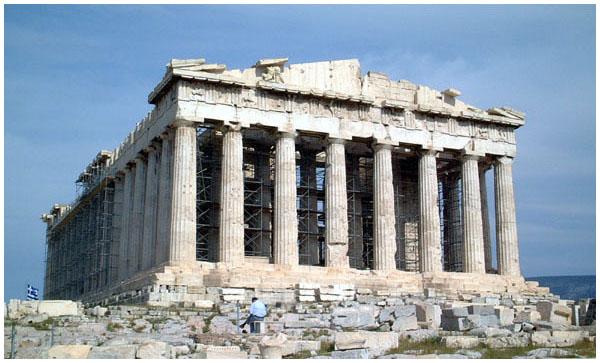

Athens had lots of new ideas coming into it because it was the center of trade during its time. “If New York City is ‘The Big Apple,’ Athens was ‘The Big Olive.’” (Video) Everyone came to them and it even started to turn into a polyglot society. However, “while absorbing what the near east had to offer…[such as architecture and religion,] the Greeks continued to make everything they took over into something astonishingly different-and original.” (Grant 11) We can see this when we look at their architecture.
“In ancient Greece, poor people and rich people lived in different kinds of houses. All houses were made of mud bricks and needed frequent repairs. Houses of the poor people were very simple compared to the houses of the rich, which had more rooms centered around a courtyard…The floors and walls in the houses were carefully created using stones, tiles, or pebbles. The nicest houses used pebbles to create mosaics. To do this, they went to the seashore and collected colored pebbles of similar sizes and arranged them in sand to make a picture or pattern on the floors or walls.”
Perhaps the most amazing parts of ancient Greek architecture were their large and gorgeous temples. We must rely on their temples for most of our information since they are one of the only surviving buildings from that time. The first stone temples appeared in large numbers during the 8th century B.C. and the 7th century B.C. “These temples were often only big enough to house a cult statue and were not meant to be places for large gatherings of people. A typical Greek temple had a long, inner chamber surrounded by columns.” “The Greek marble temples, for example, are known to have displayed blue, green, red and gold colors. The color is thought to have enhanced the optical experience of the building and to highlight the architectural sculpture.” “Beneath the temples spread public meeting places, civic buildings, gymnasiums, stadiums, theaters, and housing.” Though not much remains of these temples, we can imagine the glory they had at their peak. (source1, source2)
The three kinds of columns used by the Greeks to build these splendors and to hold up the roofs were Doric, Ionic, and Corinthian.
“The Doric order is plain and sturdy looking. It was developed by the Dorian tribes on the Greek mainland who were heavily influenced by buildings at Mycenae and Crete. The greatest example of Doric order is the Parthenon which was built around 440.”
“The Ionic order originated along the coast of the Asia Minor. The Ionic column is taller and more slender than the Doric. Unlike the Doric, the Ionic column has a base. The most distinctive feature of the ionic column is the scroll shape of the capitol, which made it slightly fancier than the Doric. The Ionic order was more popular in the eastern parts of Greece where there was an emphasis on elegance and ornamentation.”
“The Corinthian order was built to be sturdier than the Ionic order. It was also more decorative with elaborate leaf designs at the top of the columns. This was the style that most influenced Roman architecture” even though it wasn’t used that much in Greece.
“Some things today can be traced back to the ancient Greeks [as we have already
 seen,] such as theatre.” (Malam 5) The Greeks are well known for their amphitheaters. These were semi-circles “with rising tiers of seats [which look like steps] about an open space called the arena” where the orchestra would play and the actors would perform using masks to show happiness or sadness.
seen,] such as theatre.” (Malam 5) The Greeks are well known for their amphitheaters. These were semi-circles “with rising tiers of seats [which look like steps] about an open space called the arena” where the orchestra would play and the actors would perform using masks to show happiness or sadness.Many years later, one can look around and still see some of ancient Greece. “Classic Greek architecture is reflected on modern day buildings such as the Lincoln Memorial…The Lincoln Memorial uses the Doric order.” A bigger example would be the White House.
 “The White House is a grand mansion…with details that echo classical Greek Ionic architecture.
“The White House is a grand mansion…with details that echo classical Greek Ionic architecture.  James Hoban's original design was modeled after the Leinster House in Dublin, Ireland.” Thus we see that Greek architecture not only influenced America, but other countries as well.
James Hoban's original design was modeled after the Leinster House in Dublin, Ireland.” Thus we see that Greek architecture not only influenced America, but other countries as well. Works Cited
Grant, Michael. The Founders of the Western World: A History of Greece and Rome. New York: Maxwell Macmillan Publishing Company. 1991.
Malam, John. Ancient Greece. New York: Enchanted Lion Books. 2004.
Video of Greece we watched in class


4 comments:
5,5,5
HI! Be sure to visit my blog rescuethepoorfrogs@blogspot.com
I love your blog! In school, I'm doing a report on Greek and Rome and this site has helped me alot!
Oh cool! Thanks for reading! :D
Thank you for this template web template
Post a Comment